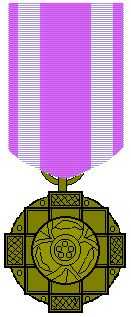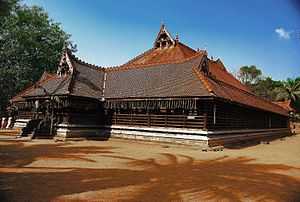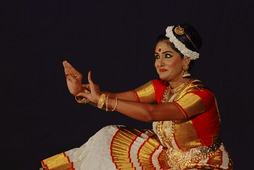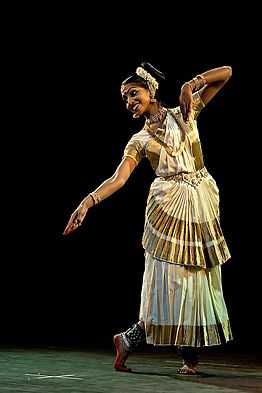Kalamandalam Satyabhama
| Kalamandalam Satyabhama | |
|---|---|
| Born |
1937 Shornur, Palakkad, Kerala, India |
| Spouse(s) | Kalamandalam Padmanabhan Nair |
| Awards |
Padma Shri Kerala Sangeetha Nataka Akademi Award Sangeet Natak Akademi Award Nruthya Natya Puraskaram Kerala Kalamandalam Award Swati Tirunal Puraskaram Shadkala Govinda Marar Award |
Mohiniyattam, also spelled Mohiniattam (Malayalam: മോഹിനിയാട്ടം), is a classical dance form from Kerala, India. Believed to have originated in 16th century CE, it is one of the eight Indian classical dance forms recognised by the Sangeet Natak Akademi. It is considered a very graceful form of dance meant to be performed as solo recitals by women.... The noted Malayalam poet Vallathol, who established the Kerala Kalamandalam dance school in 1930, played an important role in popularizing Mohiniyattam in the 20th century[1]
Kalamandalam V. Satyabhama is an Indian classical dancer, teacher and choreographer, known for her performances and scholarship in mohiniyattam and is regarded as a matriarch of the classical dance form. She is also well versed in other classical dances of Kerala. She was awarded the Padma Shri, in 2014, for her contributions to the art and culture, by the Government of India.[2][3]
| Padma Shri | |
|---|---|
 | |
| Awarded by | Government of India |
| Ribbon |
|
Biography

Satyabhama was born in 1937, in a family with limited financial resources, at Shornur, on the coast of Bharathapuzha, in Palakkad, in the south Indian state of Kerala, to Krishnan Nair, a petty businessman and Ammini Amma. She started learning dance, at a very early age, as a part-time student of Kerala Kalamandalam, under the tutelage of Kalamandalam Achutha Warrier and Kalamandalam Krishnankutty Warrier, concurrently with her academic schooling at Government High School, Shornur. After completing her 8th standard there, she joined Kalamandalam as a full-time student.[3] That was when she started learning Mohiniyattom, under the Kalamandalam stalwart, Thottassery Chinnammu Amma,[5] the first longserving dance teacher at Kalamandalam, though the main focus of study remained Bharatanatyam. Chinnammu Amma introduced the young Satyabhama to various dance techniques such as adavu (basic movements), cholkettu, jathiswarams (syllables and musical notes) in Chenchurutty and Todi.[3] Soon, the young girl came to the notice of the legendary Malayalam poet, Vallathol Narayana Menon, the founder of Kerala Kalamandalam, who nurtured the young aspirant's skills by providing her with a scholarship with which she could pay the school fees.
Satyabhama's debut on major stage was in 1955, during the silver jubilee celebrations of Kalamandalam, in front of the then Prime Minister, Jawaharlal Nehru. The next six years of study at the institution gave her opportunities to visit Singapore and Malaysia, as a part of the touring Kalamandalam troupe, where she performed Bharatanatyam, Mohiniyattam and Kathakali. After completing the course, she joined Kalamandalam as a junior teacher. She also had a stint of training from the doyen of classical dance, Kalamandalam Kalyanikutty Amma.[6]
It was during this time, Satyabhama met Kalamandalam Padmanabhan Nair, the noted Kathakali guru, widely regarded as the master of Kathakali grammar. The acquaintance, soon, took romantic notes which ended in their marriage.[6] Satyabhama and Padmanabhan Nair, at the time of the latter's death, had four daughters of which two are active in mohiniyattam.[4]
Positions
Kalamandalam Satybhama was the first woman Vice Principal of Kerala Kalamandalam and, later, became its Principal till she retired in 1992.[3][7] She sits in the selection committee to decide annual Kalamandalam fellowships[8] She is also functioning as the Dean of Kerala Kalamandalam.[4]
Legacy
.jpg)
Kalamandalam Satyabhama quietly retired from performances at a young age of 24 to attend to her duties a teacher and choreographer. As such, she is respected more for her contributions to the dance form than for her on stage performances.[4]
Satyabhama is credited with purifying the dance form by weeding out external influences. She modified the performance techniques so that the emotive aspect of the performance strictly sticks to Lasyam. She is also said to have revolutionized the mohiniyattam curriculum at Kerala Kalamandalam which is said to have resulted in the evolution of Kalamandalam style mohiniyattam.[4] She also tried to add more spice into the presentation of the dance form by evoking drama through exaggerated body kinetics through mudras (palm and finger gestures), poses and steps, which at times, have also attracted criticism.[6][7]
Another major contribution of Satyabhama is the changes she has brought to the mohiniyattam costumes.[7] The designs she has created follows Kerala traditions in color, pattern and accessories and have become the signature of Kalamandalam style. She also changed the way the dancer styles the hair, which was vaguely adapted from Raja Ravi Varma paintings.[6]
She has also left a rich legacy of 35 mohiniyattom compositions, the details of which are narrated in her book, Mohiniyattam - History, Techniques and Performance.[9]
Awards and recognitions
Satyabhama has been honored with several awards and recognitions by regional and national bodies.[3] Apart from the prestigious Padma Shri Award, she was the first to receive the Nruthya Natya Puraskaram of the Government of Kerala in 2005[10] and the first Swati Tirunal Puraskaram by Kollam Kathakali Club and Ttroupe, in 2006.[11] Some of the notable awards bestowed on Satyabhama are:
- Padma Shri - 2014
- Kerala Sangeetha Nataka Akademi Award - 1976[7]
- Sangeet Natak Akademi Award, New Delhi - 1994[12]
- Nruthya Natya Puraskaram of the Government of Kerala- 2005
- Kerala Kalamandalam Award - 1988[7]
- Swati Tirunal Puraskaram[11]
- Shadkala Govinda Marar Award - 2013[13]
Kerala Kalamandalam has instituted an award, in honor of Satyabhama, which is distributed to deserving students of mohiniyattam, in the form of a scholarship annually.[14]
Mohiniyattam postures
-
Mohiniyattam performer striking a pose
-

Mohiniyattam performer
-

Mohiniyattam performer enacting a Padam, the abinaya piece
-

A Mohiniyattam pose
Publications
Satyabhama has published a treatise on Mohiniyattam in Malayalam, by name, Mohiniyattam - History, Techniques and Performance (Malayalam: മോഹിനിയാട്ടം - ചരിത്രം, സിദ്ധാന്തം, പ്രയോഗം) which is considered a referral book on the subject and consists of 11 chapters and 35 compositions by the writer.[4][9]
- Kalamandalam Satyabhama. Mohiniyattam - History, Techniques and Performance. Mathrubhumi Books.
See also
- Kalamandalam Padmanabhan Nair
- Kalamandalam Kalyanikutty Amma
- Mohiniyattam
References
- ↑ "Mohiniyattom". Retrieved July 26, 2014.
- ↑ "Govt announcement". Retrieved July 27, 2014.
- ↑ 3.0 3.1 3.2 3.3 3.4 "The Hindu". Retrieved July 25, 2014.
- ↑ 4.0 4.1 4.2 4.3 4.4 4.5 "Times of India". Retrieved July 25, 2014.
- ↑ "Chinnammu Amma". Retrieved July 25, 2014.
- ↑ 6.0 6.1 6.2 6.3 6.4 "Book Review". Retrieved July 25, 2014.
- ↑ 7.0 7.1 7.2 7.3 7.4 "Kerala Tourism". Retrieved July 27, 2014.
- ↑ "Committee". Retrieved July 25, 2014.
- ↑ 9.0 9.1 "Book". Retrieved July 25, 2014.
- ↑ "Recognition for a Guru - The Hindu". Retrieved July 26, 2014.
- ↑ 11.0 11.1 "Swati". Retrieved July 26, 2014.
- ↑ "Kendra Akademi". Retrieved July 27, 2014.
- ↑ "Shadkala award". Retrieved July 26, 2014.
- ↑ "Satayabhama Award". Retrieved July 27, 2014.
External links
- Profile on Kerala Tourism web site
- Reference on Narthaki.com
- Satyabhama Award recipient
- Honouring Satyabhama 1
- Honouring Satyabhama 2
| ||||||||||||||||||||||||||||||
